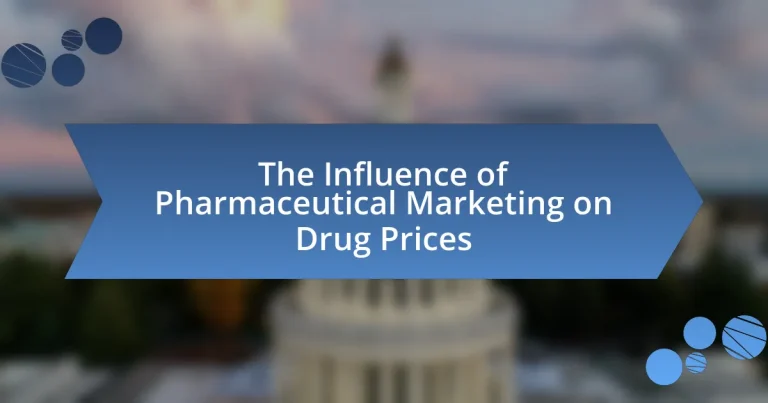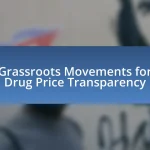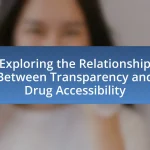The article examines the significant influence of pharmaceutical marketing on drug prices, highlighting how marketing strategies drive demand and shape perceptions of value among consumers and healthcare providers. It discusses various marketing techniques, such as direct-to-consumer advertising and physician detailing, and their impact on pricing strategies and consumer perceptions. The article also addresses the economic implications of high drug prices, the ethical considerations surrounding marketing practices, and the importance of consumer awareness in navigating these complexities. Additionally, it explores potential regulatory frameworks and strategies to mitigate the influence of pharmaceutical marketing on drug pricing.
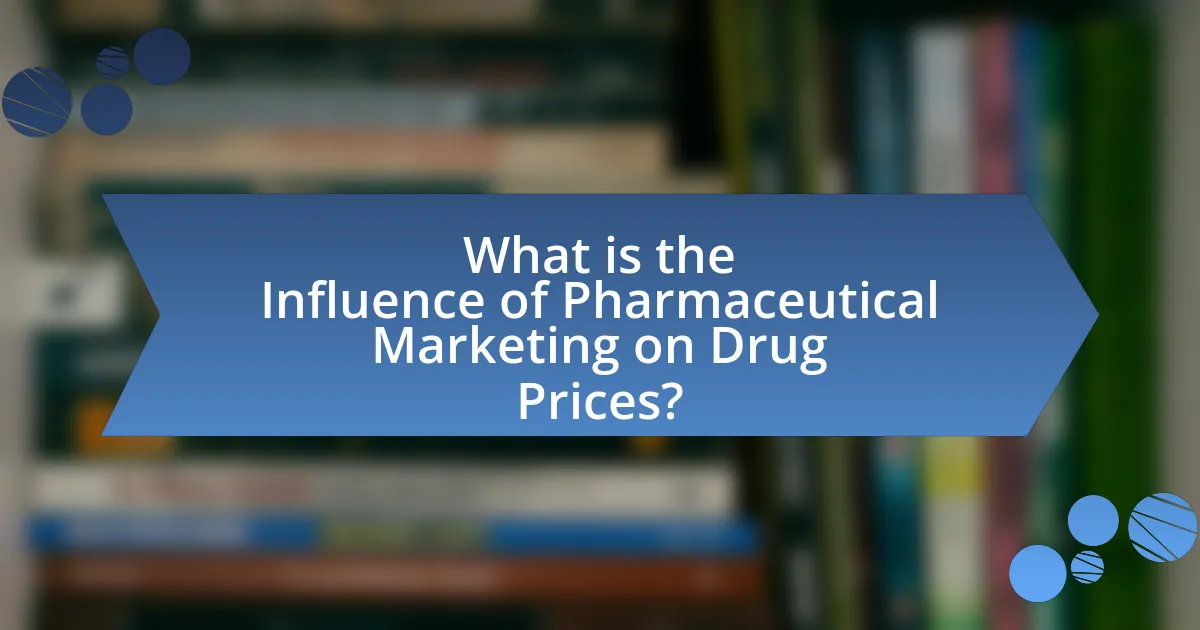
What is the Influence of Pharmaceutical Marketing on Drug Prices?
Pharmaceutical marketing significantly influences drug prices by driving demand and shaping perceptions of value among healthcare providers and consumers. Marketing strategies, including direct-to-consumer advertising and promotional activities targeting physicians, create brand loyalty and increase the perceived necessity of certain medications. For instance, a study published in the Journal of the American Medical Association found that pharmaceutical companies spent approximately $29.9 billion on marketing in 2016, which correlates with higher drug prices. This investment in marketing not only elevates the visibility of specific drugs but also contributes to the overall pricing strategies employed by pharmaceutical companies, often leading to higher costs for consumers and healthcare systems.
How does pharmaceutical marketing impact drug pricing strategies?
Pharmaceutical marketing significantly influences drug pricing strategies by creating perceived value and demand for medications. Marketing campaigns often emphasize the benefits and unique features of a drug, which can lead to higher pricing as companies capitalize on the established brand image and consumer awareness. For instance, a study published in the Journal of Managed Care & Specialty Pharmacy found that direct-to-consumer advertising can increase the demand for specific drugs, allowing manufacturers to set higher prices due to increased market interest. Additionally, promotional activities targeting healthcare providers can lead to prescribing patterns that favor higher-priced medications over generics, further impacting overall pricing strategies in the pharmaceutical market.
What are the key marketing techniques used in the pharmaceutical industry?
The key marketing techniques used in the pharmaceutical industry include direct-to-consumer advertising, physician detailing, and digital marketing strategies. Direct-to-consumer advertising allows pharmaceutical companies to promote their products directly to patients through television, print, and online media, increasing awareness and demand. Physician detailing involves sales representatives providing information and samples to healthcare professionals, influencing their prescribing habits. Digital marketing strategies encompass social media campaigns, search engine optimization, and targeted online advertisements, which enhance engagement and reach specific demographics. These techniques collectively contribute to shaping consumer perceptions and driving drug sales, ultimately impacting drug pricing in the market.
How do these techniques influence consumer perception of drug value?
Pharmaceutical marketing techniques significantly influence consumer perception of drug value by creating a perception of necessity and efficacy. For instance, direct-to-consumer advertising often emphasizes the benefits of a drug while downplaying potential side effects, leading consumers to believe that the drug is essential for their health. Research published in the Journal of Health Economics indicates that such marketing strategies can increase the perceived value of a drug by up to 30%, as consumers equate high advertising expenditure with higher quality and effectiveness. Additionally, promotional tactics like celebrity endorsements and patient testimonials further enhance the perceived credibility and desirability of the drug, reinforcing the notion that it is worth its price.
Why is understanding pharmaceutical marketing important for consumers?
Understanding pharmaceutical marketing is important for consumers because it directly impacts their healthcare decisions and financial well-being. Consumers who grasp the strategies used in pharmaceutical marketing can better evaluate drug efficacy, safety, and pricing, leading to more informed choices. For instance, a study published in the Journal of the American Medical Association found that direct-to-consumer advertising can significantly influence patients’ requests for specific medications, often without a full understanding of the associated risks or costs. This awareness helps consumers navigate the complexities of drug pricing and promotes more responsible healthcare consumption.
What role does consumer awareness play in drug pricing?
Consumer awareness significantly influences drug pricing by empowering individuals to make informed choices about their medications. When consumers are knowledgeable about drug prices, alternatives, and the factors affecting pricing, they can advocate for fairer prices and seek out more affordable options. Research indicates that increased consumer awareness can lead to competitive pricing, as pharmaceutical companies may adjust their prices in response to informed consumers who compare costs and demand transparency. For instance, a study published in the Journal of Health Economics found that states with prescription drug price transparency laws saw a reduction in prices, demonstrating the direct impact of consumer awareness on drug pricing dynamics.
How can consumers make informed decisions regarding medications?
Consumers can make informed decisions regarding medications by researching drug information, consulting healthcare professionals, and comparing prices. Accessing reliable sources such as the FDA website or peer-reviewed journals provides essential details about medication efficacy, side effects, and interactions. Engaging with pharmacists or doctors allows consumers to clarify doubts and receive personalized advice based on their health conditions. Additionally, utilizing price comparison tools and websites can help consumers identify the most cost-effective options, as studies indicate that price variations for the same medication can be significant across different pharmacies.
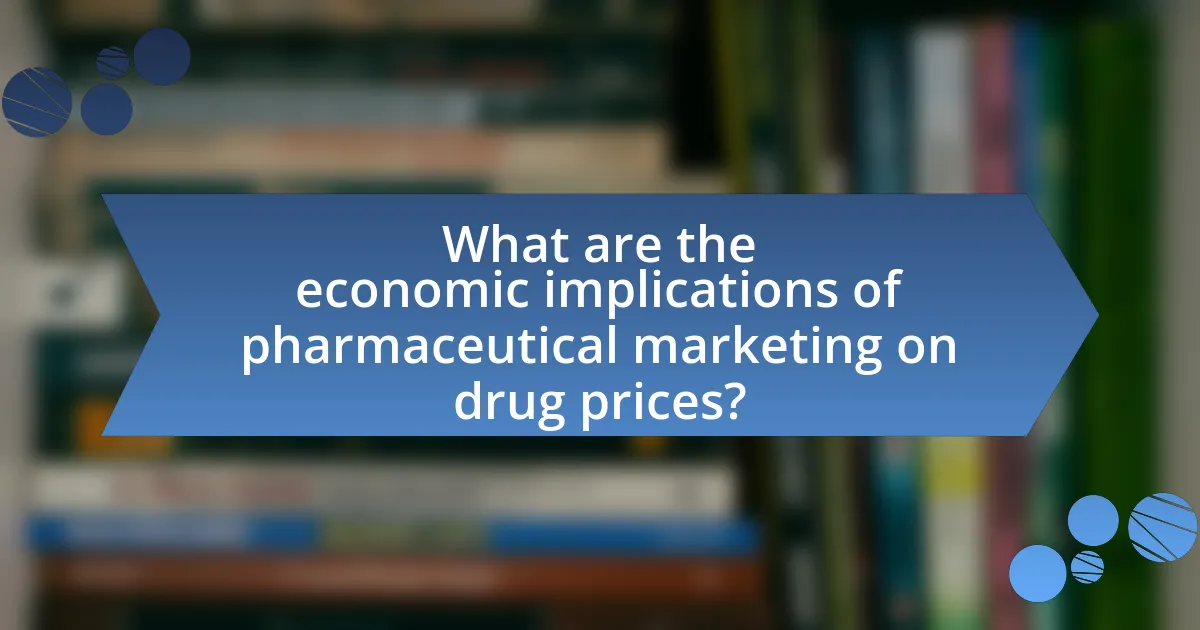
What are the economic implications of pharmaceutical marketing on drug prices?
Pharmaceutical marketing significantly increases drug prices by creating demand through advertising and promotional strategies. This marketing often leads to higher expenditures for consumers and healthcare systems, as companies invest heavily in marketing to differentiate their products and justify premium pricing. For instance, a study published in the Journal of the American Medical Association found that pharmaceutical companies spent approximately $29.9 billion on marketing in 2016, which contributed to the rising costs of medications. Additionally, the presence of direct-to-consumer advertising has been linked to increased prescription rates, further driving up prices. Thus, the economic implications of pharmaceutical marketing manifest in elevated drug costs and increased financial burdens on patients and healthcare providers.
How does pharmaceutical marketing contribute to overall healthcare costs?
Pharmaceutical marketing significantly contributes to overall healthcare costs by driving up drug prices through extensive promotional expenditures. In 2020, the pharmaceutical industry spent approximately $6.58 billion on direct-to-consumer advertising alone, which influences patient demand and prescribing patterns. This marketing strategy often leads to higher prices for medications, as companies seek to recoup their advertising investments and maximize profits. Additionally, studies indicate that increased marketing efforts correlate with higher drug prices; for instance, a 2016 study published in the Journal of the American Medical Association found that for every $1 million spent on marketing, drug prices increased by an average of 1.2%. Thus, pharmaceutical marketing not only elevates drug prices but also contributes to the overall escalation of healthcare costs.
What are the long-term effects of high drug prices on public health?
High drug prices have significant long-term effects on public health, primarily leading to reduced access to necessary medications. When medications are priced beyond the reach of many individuals, it results in lower adherence to prescribed treatments, which can exacerbate chronic conditions and lead to increased morbidity and mortality rates. For instance, a study published in the Journal of the American Medical Association found that nearly 25% of patients reported not filling prescriptions due to high costs, which directly correlates with poorer health outcomes. Additionally, high drug prices can strain healthcare systems, as untreated conditions often lead to more severe health issues that require costly emergency interventions. This cycle not only affects individual health but also places a financial burden on public health resources, ultimately compromising the overall health of the population.
How do marketing expenses compare to research and development costs?
Marketing expenses in the pharmaceutical industry often exceed research and development costs. For instance, a 2019 study published in the Journal of the American Medical Association found that pharmaceutical companies spent approximately $30 billion on marketing, while their R&D expenditures averaged around $20 billion. This trend indicates that marketing strategies, including advertising and promotional activities, can significantly overshadow the investment in developing new drugs, highlighting the prioritization of market presence over innovation in some cases.
What regulatory frameworks exist to manage pharmaceutical marketing?
Regulatory frameworks that manage pharmaceutical marketing include the Food, Drug, and Cosmetic Act in the United States, which mandates that drug advertisements must be truthful and not misleading. Additionally, the Federal Trade Commission enforces regulations against deceptive marketing practices. In Europe, the European Medicines Agency oversees compliance with the EU Directive on the promotion of medicinal products, which requires that marketing communications are clear and not misleading. These frameworks are designed to ensure that pharmaceutical marketing is conducted ethically and transparently, thereby protecting consumers and maintaining market integrity.
How effective are current regulations in controlling drug prices?
Current regulations are moderately effective in controlling drug prices, but significant gaps remain. For instance, regulations such as the Affordable Care Act and various state-level initiatives aim to increase transparency and limit price hikes; however, many pharmaceutical companies still employ strategies like price increases and patent extensions to circumvent these controls. According to a 2021 report by the House of Representatives, nearly 1 in 4 Americans reported not filling a prescription due to high costs, indicating that existing regulations do not fully address the issue of affordability. Additionally, a study published in the Journal of the American Medical Association found that while some regulations have led to lower prices for certain drugs, overall spending on prescription medications continues to rise, suggesting that current measures are insufficient in providing comprehensive price control.
What changes could improve the regulation of pharmaceutical marketing?
Enhancing the regulation of pharmaceutical marketing could be achieved by implementing stricter transparency requirements for advertising expenditures and clinical trial data. These changes would ensure that pharmaceutical companies disclose the financial incentives provided to healthcare professionals and the outcomes of clinical trials, which can influence prescribing behaviors. For instance, the Physician Payments Sunshine Act in the United States mandates disclosure of payments to physicians, which has increased transparency and accountability in the industry. Additionally, enforcing stricter penalties for misleading advertisements could deter companies from making unsubstantiated claims about their products, thereby protecting consumers and healthcare providers from misinformation.
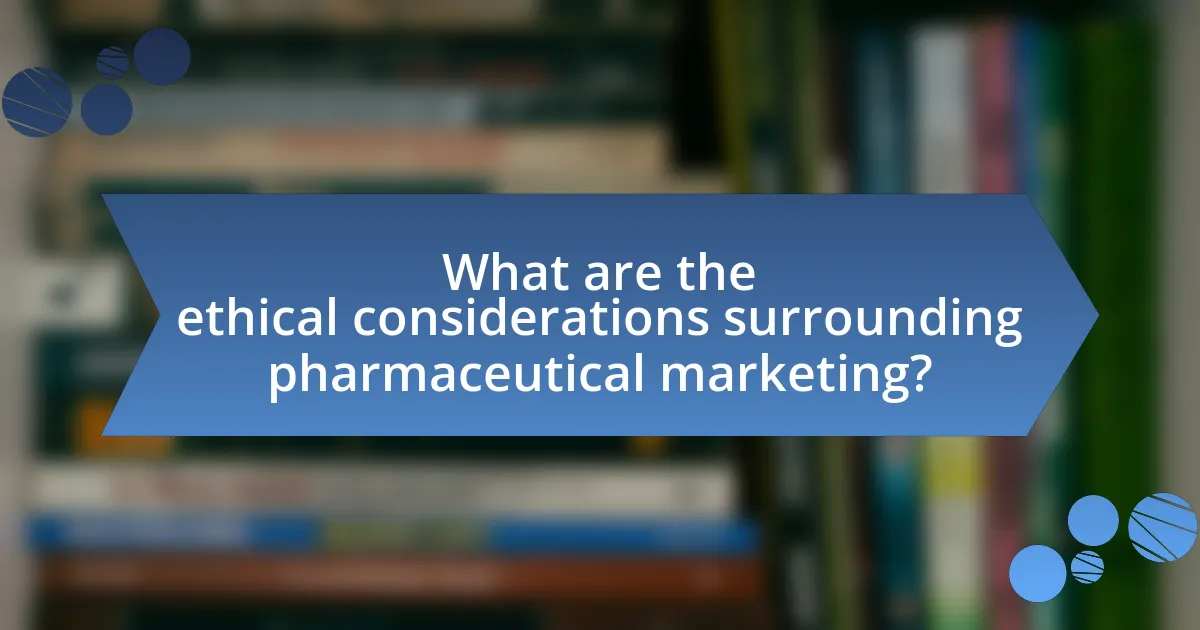
What are the ethical considerations surrounding pharmaceutical marketing?
The ethical considerations surrounding pharmaceutical marketing include transparency, the potential for misleading information, and the impact on healthcare decisions. Transparency is crucial as pharmaceutical companies must disclose potential conflicts of interest and the financial incentives behind their marketing strategies. Misleading information can arise when marketing exaggerates the benefits or downplays the risks of medications, which can lead to inappropriate prescribing practices. Additionally, aggressive marketing tactics may influence healthcare providers’ decisions, prioritizing profit over patient welfare. According to a study published in the Journal of the American Medical Association, pharmaceutical marketing significantly affects prescribing behavior, raising concerns about the integrity of medical decisions and patient safety.
How does pharmaceutical marketing affect physician prescribing behavior?
Pharmaceutical marketing significantly influences physician prescribing behavior by shaping their perceptions and preferences for specific medications. Studies have shown that promotional activities, such as detailing by pharmaceutical representatives and direct-to-physician advertising, can lead to increased prescriptions of marketed drugs. For instance, a study published in the Journal of the American Medical Association found that physicians exposed to marketing were more likely to prescribe the promoted medications over alternatives, even when clinical guidelines suggested otherwise. This correlation indicates that marketing strategies effectively alter prescribing patterns, often prioritizing brand-name drugs over generics, which can impact overall healthcare costs.
What are the potential conflicts of interest in pharmaceutical marketing?
Potential conflicts of interest in pharmaceutical marketing include the influence of financial incentives on healthcare professionals, which can lead to biased prescribing practices. Pharmaceutical companies often provide gifts, funding for research, or speaking fees to doctors, creating a situation where the interests of the company may overshadow patient care. For instance, a study published in the Journal of the American Medical Association found that physicians who received payments from drug companies were more likely to prescribe those companies’ medications, regardless of their efficacy. Additionally, marketing strategies may prioritize profit over patient safety, as seen in cases where aggressive promotion of certain drugs has led to public health crises, such as the opioid epidemic. These conflicts can ultimately distort the healthcare decision-making process, affecting drug prices and accessibility for patients.
How can transparency in marketing practices benefit patients?
Transparency in marketing practices can benefit patients by fostering trust and enabling informed decision-making regarding their healthcare options. When pharmaceutical companies openly disclose information about drug pricing, marketing strategies, and potential conflicts of interest, patients can better understand the value and efficacy of medications. For instance, a study published in the Journal of Health Economics found that transparency in drug pricing can lead to lower costs for patients, as it encourages competition among manufacturers and helps patients make choices based on accurate information. This informed decision-making ultimately enhances patient outcomes and satisfaction with their treatment options.
What strategies can be employed to mitigate the influence of pharmaceutical marketing?
To mitigate the influence of pharmaceutical marketing, regulatory measures such as stricter advertising guidelines and transparency requirements can be implemented. These measures can limit the scope of direct-to-consumer advertising and require pharmaceutical companies to disclose the financial relationships with healthcare providers. For instance, the American Medical Association has advocated for policies that restrict pharmaceutical marketing practices, emphasizing the need for transparency to reduce conflicts of interest. Additionally, educational initiatives aimed at healthcare professionals can enhance awareness of marketing tactics, enabling them to make more informed prescribing decisions. Research indicates that when physicians are educated about the potential biases introduced by pharmaceutical marketing, they are less likely to prescribe brand-name drugs over generics, ultimately leading to lower drug costs for patients.
How can healthcare professionals advocate for fair drug pricing?
Healthcare professionals can advocate for fair drug pricing by actively participating in policy discussions and supporting legislation aimed at regulating pharmaceutical prices. By leveraging their expertise and credibility, they can influence lawmakers to consider the impact of high drug costs on patient care and public health. For instance, a study published in the Journal of the American Medical Association found that healthcare professionals’ advocacy efforts significantly contributed to the passage of state-level drug pricing transparency laws, which aim to provide clearer information on drug costs and promote accountability among pharmaceutical companies.
What role do patient advocacy groups play in addressing drug pricing issues?
Patient advocacy groups play a crucial role in addressing drug pricing issues by representing the interests of patients and influencing policy changes. These organizations mobilize patients to advocate for affordable medications, raise awareness about the impact of high drug prices, and engage in lobbying efforts to promote legislative reforms. For instance, groups like the American Cancer Society and Patients for Affordable Drugs have successfully campaigned for price transparency and have pushed for policies that limit price increases, demonstrating their effectiveness in shaping public discourse and policy regarding drug affordability.
What practical steps can consumers take to navigate pharmaceutical marketing?
Consumers can navigate pharmaceutical marketing by critically evaluating advertisements, seeking unbiased information, and consulting healthcare professionals. By analyzing marketing claims and comparing them with independent research, consumers can discern the efficacy and safety of medications. Additionally, utilizing resources like the FDA’s website or reputable medical journals can provide factual insights. Engaging in discussions with healthcare providers allows consumers to clarify doubts and make informed decisions, ultimately leading to better health outcomes and potentially lower costs associated with unnecessary medications.
